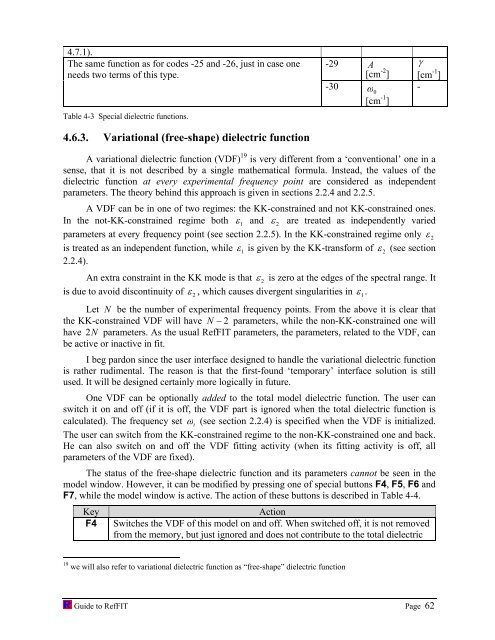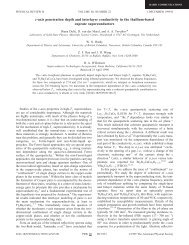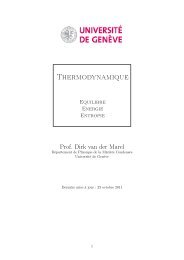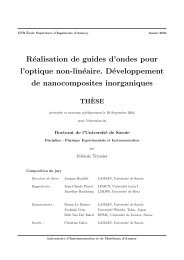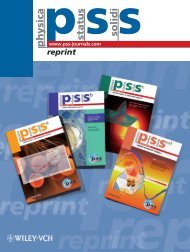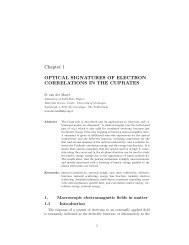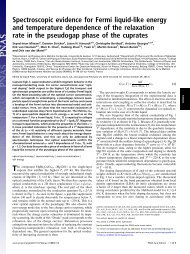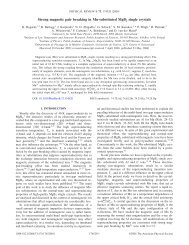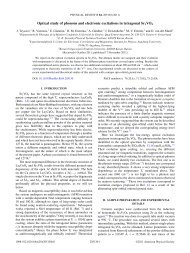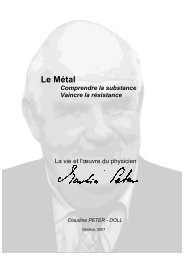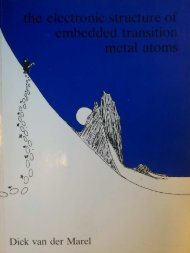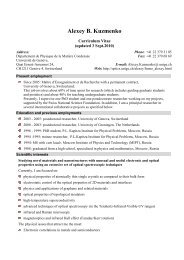software to fit optical spectra - Quantum Materials Group
software to fit optical spectra - Quantum Materials Group
software to fit optical spectra - Quantum Materials Group
Create successful ePaper yourself
Turn your PDF publications into a flip-book with our unique Google optimized e-Paper software.
4.7.1).<br />
The same function as for codes -25 and -26, just in case one<br />
needs two terms of this type.<br />
Table 4-3 Special dielectric functions.<br />
4.6.3. Variational (free-shape) dielectric function<br />
-29 A<br />
[cm -2 ]<br />
-30<br />
ω 0<br />
[cm -1 ]<br />
γ<br />
[cm -1 ]<br />
-<br />
A variational dielectric function (VDF) 19 is very different from a ‘conventional’ one in a<br />
sense, that it is not described by a single mathematical formula. Instead, the values of the<br />
dielectric function at every experimental frequency point are considered as independent<br />
parameters. The theory behind this approach is given in sections 2.2.4 and 2.2.5.<br />
A VDF can be in one of two regimes: the KK-constrained and not KK-constrained ones.<br />
In the not-KK-constrained regime both ε 1 and ε 2 are treated as independently varied<br />
parameters at every frequency point (see section 2.2.5). In the KK-constrained regime only ε 2<br />
is treated as an independent function, while ε 1 is given by the KK-transform of ε 2 (see section<br />
2.2.4).<br />
An extra constraint in the KK mode is that ε 2 is zero at the edges of the <strong>spectra</strong>l range. It<br />
is due <strong>to</strong> avoid discontinuity of ε 2 , which causes divergent singularities in ε 1.<br />
Let N be the number of experimental frequency points. From the above it is clear that<br />
the KK-constrained VDF will have N − 2 parameters, while the non-KK-constrained one will<br />
have 2 N parameters. As the usual RefFIT parameters, the parameters, related <strong>to</strong> the VDF, can<br />
be active or inactive in <strong>fit</strong>.<br />
I beg pardon since the user interface designed <strong>to</strong> handle the variational dielectric function<br />
is rather rudimental. The reason is that the first-found ‘temporary’ interface solution is still<br />
used. It will be designed certainly more logically in future.<br />
One VDF can be optionally added <strong>to</strong> the <strong>to</strong>tal model dielectric function. The user can<br />
switch it on and off (if it is off, the VDF part is ignored when the <strong>to</strong>tal dielectric function is<br />
calculated). The frequency set ω i (see section 2.2.4) is specified when the VDF is initialized.<br />
The user can switch from the KK-constrained regime <strong>to</strong> the non-KK-constrained one and back.<br />
He can also switch on and off the VDF <strong>fit</strong>ting activity (when its <strong>fit</strong>ting activity is off, all<br />
parameters of the VDF are fixed).<br />
The status of the free-shape dielectric function and its parameters cannot be seen in the<br />
model window. However, it can be modified by pressing one of special but<strong>to</strong>ns F4, F5, F6 and<br />
F7, while the model window is active. The action of these but<strong>to</strong>ns is described in Table 4-4.<br />
Key Action<br />
F4 Switches the VDF of this model on and off. When switched off, it is not removed<br />
from the memory, but just ignored and does not contribute <strong>to</strong> the <strong>to</strong>tal dielectric<br />
19 we will also refer <strong>to</strong> variational dielectric function as “free-shape” dielectric function<br />
Guide <strong>to</strong> RefFIT Page 62


